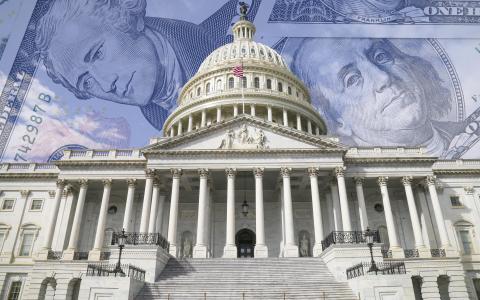
(Reuters) - A potential debt ceiling standoff in the United States next year could be one of the worst since the 2011 crisis, which may trigger another sovereign credit rating downgrade, said Gennadiy Goldberg, the head of U.S. rates strategy at TD Securities.
Congress has suspended the debt ceiling until Jan. 1, 2025, even as worries over rising U.S. debt were fueled earlier this week when the Congressional Budget Office (CBO) forecast a jump in the deficit to $1.915 trillion for fiscal 2024 and $1.938 trillion for 2025.
"I certainly worry about debt sustainability. The path of U.S. deficits is highly unsustainable," Gennadiy Goldberg told the Reuters Global Markets Forum (GMF).
"We'll get the first whiff of politicians starting to come under a bit of pressure when the U.S. credit rating is downgraded again ... possibly as soon as next year."
S&P downgraded its U.S. credit rating for the first time in history during the 2011 debt ceiling crisis, which prompted the passage of the Budget Control Act of 2011 to cut spending and identify deficit reduction measures.
Goldberg said there was a risk that S&P will downgrade its U.S. sovereign rating by another notch, this time from AA+ to AA.
Last year, Fitch downgraded its U.S. long-term credit ratings, and Moody's lowered its outlook to 'negative' from 'stable' signaling an increased risk of a downgrade.
The 5-year credit default swaps (CDS) on U.S. sovereign debt indicate some worry, Goldberg said, as spreads have not receded to the levels they were at the past few years.
The convexity-adjusted spread on the 5-year CDS, one of the most-traded contracts during crises, is at around 40 basis points this month, almost double the past five-year average, data from HIS Markit showed.
Still, some market participants see a limited impact from a sovereign rating downgrade due to lack of suitable alternatives to high-quality liquid assets such as U.S. Treasury securities.
"Curiously, the term premium in the U.S. hasn't materially increased in recent months, suggesting the demand for U.S. debt remains quite strong," Goldberg said.
"The big question is whether that demand will persist, and who will buy the bonds once that demand cools."
By Mehnaz Yasmin
Editing by Divya Chowdhury and Kim Coghill



